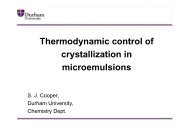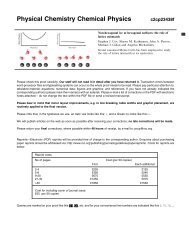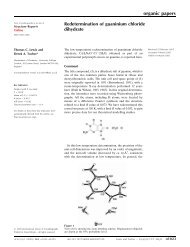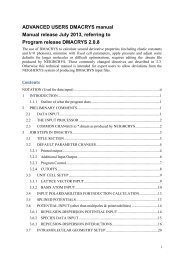An Introduction to the Theory of Crystalline Elemental Solids and ...
An Introduction to the Theory of Crystalline Elemental Solids and ...
An Introduction to the Theory of Crystalline Elemental Solids and ...
You also want an ePaper? Increase the reach of your titles
YUMPU automatically turns print PDFs into web optimized ePapers that Google loves.
40<br />
FIG. 20: Computed work function <strong>of</strong> jellium as a function <strong>of</strong> r s along with measured experimental<br />
values for polycrystalline surfaces (after ref. [149]).<br />
where µ is <strong>the</strong> electron chemical potential, which in a metal at 0 K is equal <strong>to</strong> <strong>the</strong> Fermi<br />
level (as discussed in section 4). Thus we arrive at <strong>the</strong> definition <strong>of</strong> <strong>the</strong> work function as<br />
<strong>the</strong> minimum work necessary <strong>to</strong> remove an electron from a metal at 0 K [152].<br />
Clearly <strong>the</strong> more <strong>the</strong> electrons spill in<strong>to</strong> <strong>the</strong> vacuum, <strong>the</strong> larger D is. Indeed Φ generally<br />
increases with decreasing r s as is illustrated by Fig. 20(a) where <strong>the</strong> work function<br />
<strong>of</strong> jellium is plotted as a function <strong>of</strong> r s along with several experimental values for<br />
polycrystalline metals. It can also be seen from <strong>the</strong> plot that <strong>the</strong> trend predicted by<br />
jellium is indeed observed with experimental measurements on real crystals. Moreover,<br />
<strong>the</strong> absolute values <strong>of</strong> Φ predicted with <strong>the</strong> jellium model fall in <strong>the</strong> range 2-4 eV <strong>and</strong><br />
come within 10-20 % <strong>of</strong> experiment for each <strong>of</strong> <strong>the</strong> sp metals listed.<br />
A similar reasoning, although with <strong>the</strong> necessary introduction <strong>of</strong> a crystal lattice, explains<br />
<strong>the</strong> well-established fact that for real crystals, Φ can differ from one facet <strong>to</strong> <strong>the</strong> o<strong>the</strong>r, a<br />
concept known as work function anisotropy. For example, <strong>the</strong> measured values <strong>of</strong> Φ for<br />
<strong>the</strong> (111), (100), <strong>and</strong> (110) surfaces <strong>of</strong> Cu are 4.74, 4.64, <strong>and</strong> 4.52 eV, respectively [51].<br />
Since µ or E F in eqn. (39) is a bulk quantity <strong>the</strong> anisotropy in Φ comes directly from<br />
<strong>the</strong> different dipoles established at <strong>the</strong> different surfaces. Generally it is known that <strong>the</strong><br />
more open a surface, <strong>the</strong> smaller D is <strong>and</strong> consequently <strong>the</strong> smaller Φ is, as we see for Cu<br />
above. Obviously, for jellium D is <strong>the</strong> same for all surface orientations. However, for a<br />
real crystal, say fcc, <strong>the</strong> electron density is quite smooth at <strong>the</strong> (111) surface getting more<br />
corrugated at <strong>the</strong> more open surfaces. In <strong>the</strong> latter situations <strong>the</strong> electron density will<br />
smoo<strong>the</strong>n out parallel <strong>to</strong> <strong>the</strong> surface <strong>to</strong> lower <strong>the</strong> kinetic energy, <strong>and</strong> as a consequence <strong>the</strong><br />
surface dipole moment will be reduced compared <strong>to</strong> that <strong>of</strong> <strong>the</strong> closer packed surfaces.<br />
7.2 Transition Metal Surfaces: B<strong>and</strong> Narrowing <strong>and</strong> Surface Core Level Shifts<br />
As we know tight binding arguments are more appropriate than jellium when seeking <strong>to</strong><br />
gain qualitative insight <strong>of</strong> transition metal surfaces. In tight binding language <strong>the</strong> surface<br />
suppresses a certain number <strong>of</strong> hopping integrals, since <strong>the</strong> surface a<strong>to</strong>ms have lost some<br />
neighbors in any sphere <strong>of</strong> coordination. This reduces <strong>the</strong> average width <strong>of</strong> <strong>the</strong> PDOS on a







